Bouteilles à gaz — Bouteilles à gaz en acier sans soudure — Gas cylinders Periodic inspection and testing
ii

© ISO 2005
All rights reserved. Unless otherwise specified, no part of this publication may be reproduced or utilized in any form or by any means, electronic or mechanical, including photocopying and microfilm, without permission in writing from either ISO at the address below or ISO’s member body in the country of the requester.
ISO copyright office
Case postale 56 • CH-1211 Geneva 20
Tel. + 41 22 749 01 11
Fax + 41 22 749 09 47
Contents
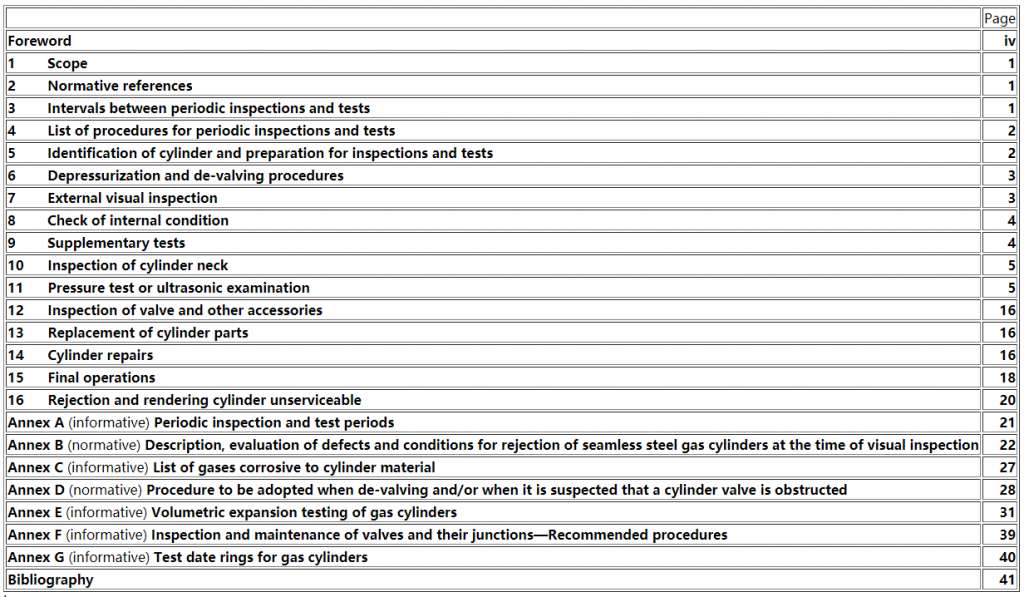
iv
Foreword
ISO (the International Organization for Standardization) is a worldwide federation of national standards bodies (ISO member bodies). Preparing international Standards is normally carried out through ISO technical committees. Each member body interested in a subject for which a technical committee has been established has the right to be represented on that committee. International organizations, governmental and non-governmental, in liaison with ISO also take part in the work. ISO collaborates closely with the International Electrotechnical Commission (IEC) on all matters of electrotechnical standardization.
International Standards are drafted by the rules given in the ISO/IEC Directives, Part 2.
The main task of technical committees is to prepare International Standards. Draft International Standards adopted by the technical committees are circulated to the member bodies for voting. Publication as an International Standard requires approval by at least 75% of the member bodies casting a vote.
Attention is drawn to the possibility that some of this document’s elements may be the subject of patent rights. ISO is not responsible for identifying any or all such patent rights.
ISO 6406 was prepared by the Technical Committee ISO/TC 58, gas cylinders, subcommittee SC 4, and operational requirements for gas cylinders.
This second edition cancels and replaces the first edition (ISO 6406: 1992), which has been technically revised.v
Gas cylinders—Seamless steel gas cylinders—Periodic inspection and testing
1 Scope
This International Standard deals with seamless steel transportable gas cylinders (single or those that comprise a bundle) intended for compressed and liquefied gases under pressure, of water capacity from 0,5l up to 150 l; it also applies, as far as practical, to cylinders of less than 0,5 l water capacity.
This International Standard specifies the requirements for periodic inspection and testing to verify the integrity of such gas cylinders to be re-introduced into service for a further period of time.
This International Standard does not apply to periodic inspection and testing of acetylene cylinders or composite cylinders with steel liners.
2 Normative references
The following referenced documents are indispensable for the application of this document. For dated references, only the edition cited applies. For undated references, the latest edition of the referenced document (including any amendments) applies.
ISO 9712:—1), Non-destructive testing—Qualification and certification of personnel
ISO 11114-1:1997, Transportable gas cylinders—Compatibility of cylinder and valve materials with gas contents—Part 1: Metallic materials
ISO 11621, Gas cylinders—Procedures for change of gas service
ISO 13341, Transportable gas cylinders—Fitting of valves to gas cylinders
ISO 13769, Gas cylinders—Stamp marking
3 Intervals between periodic inspections and tests
A cylinder shall be due for periodic inspection and test on its first receipt of a filler following the expiry of the interval established in accordance with the requirements of the United Nations Recommendations on the Transport of Dangerous Goods—Model Regulations or as specified by national or international authorities (see Annex A).
Provided the cylinder has been subjected to normal conditions of use and has not been subjected to abusive and abnormal conditions that would render the cylinder unsafe, there is no general requirement for the user to return a gas cylinder before the contents have been used even though the periodic inspection and test interval may have lapsed.
1) To be published. (Revision of ISO 9712:1999)1
The owner or user must submit the cylinder for periodic inspection and test within the interval specified by national or international authorities or as defined in the relevant cylinder design standard if this is shorter.
4 List of procedures for periodic inspections and tests
Each cylinder shall be submitted to regular inspections and tests. The following guidelines, where applicable, form the requirements for such examinations and tests and are explained more fully in later clauses:
- identification of cylinder and preparation for examination and tests (Clause 5);
- depressurization and de–valving (Clause 6);
- external visual inspection (Clause 7);
- check of internal condition (Clause 8);
- supplementary tests (Clause 9);
- inspection of cylinder neck (Clause 10);
- pressure test or ultrasonic examination (Clause 11);
- inspection of the valve and other accessories (Clause 12);
- replacement of cylinder parts (Clause 13);
- cylinder repairs (Clause 14);
- final operations (Clause 15);
- rejection and rendering the cylinder unserviceable (Clause 16).
It is recommended that the procedures a) to l) be performed in the sequence listed. In particular, the check of the internal condition [d)] should be carried out before the pressure test or before the ultrasonic examination [g)].
Cylinders that fail an inspection or test shall be rejected (see Clause 16). Where a cylinder passes the above-listed procedures but the condition of the cylinder remains in doubt, additional tests shall be performed to confirm its suitability for continued service (see Clause 9), or the cylinder shall be rendered unserviceable.
Some cylinders may be recovered depending on the reason for rejection (see Annex B).
The inspections and tests shall be carried out only by persons competent in the subject and authorized under the relevant regulations.
Heat exposure may affect the mechanical properties of steel cylinders. Therefore, the manufacturer recommends limiting the maximum temperature for any operation.
5 Identification of cylinder and preparation for inspections and tests
Before any work is carried out, the relevant cylinder data and its contents and ownership shall be identified (e.g., from the labelling and stamping, see ISO 13769). Cylinders with incorrect or illegible markings or unknown gas contents shall be set aside for special handling.
Only those cylinders manufactured or qualified as hydrogen cylinders shall be used for that service if the contents are identified as hydrogen or other embrittling gas. It shall be checked that the cylinder is2
compatible for hydrogen service, i.e., themum tensile strength and internal surface condition. Cylinders by ISO 13769 are stamped “H.”
All other cylinders shall be withdrawn from hydrogen service and checked for suitability for their new, intended service (see ISO 11621).
6 Depressurization and de-valving procedures
6.1 General (Gas cylinders Periodic inspection and testing)
Cylinders to be internally inspected or tested by a pressure test must be depressurized and devolved. Cylinders not internally visually inspected and tested by ultrasonic examination do not require complete depressurization and de-valving unless the ultrasonic examination indicates there is an unacceptable flaw present and the inspector wishes to investigate further (see 11.4)
6.2 Cylinders requiring depressurization
Cylinders shall be depressurized and emptied safely and controlled before proceeding. Particular attention shall be given to cylinders containing flammable, oxidizing, corrosive, or toxic gases to eliminate risks at the internal inspection stage. See Annex C.
Before removing any pressure retaining accessory, e.g., valve, flange, etc., a positive check shall be performed to ensure that the cylinder does not contain any gas under pressure. This may be performed as described in Annex D using the device as s,hown in Figure D.1.
Cylinders with inoperative or blocked valves shall be treated as Annex D outlines.
Similarly, in the case of cylinders disassembled from bundles and not equipped with cylinder valves, the connecting “T”–junctions shall also be checked to determine whether the gas is able to pass freely from the cylinders using, for example, the device shown in Figure D.1.
Provided the requirements previously stated have been complied with, the cylinder shall be depressurized safely and the valve shall be removed.
6.3 Cylinders not requiring de-valving
Cylinders shall be depressurized to below 5 bar before ultrasonic examination. For cylinders under inspection by the ultrasonic method, see 11.4.
7 External visual inspection
7.1 Preparation for external visual inspection
When necessary, the cylinder shall be cleaned and have all loose coatings, corrosion products, tar, oil or other foreign matter removed from its external surface by a suitable method, e.g. by brushing, shot-blasting (under closely controlled conditions), water jet abrasive cleaning, chemical cleaning or other suitable methods. The method used to clean the cylinder shall be a validated, controlled process. Care shall be taken at all times to avoid damaging the cylinder or removing excess amounts of cylinder wall (see Annex B).
If nylon, polyethene or a similar coating has been applied and the coating is seen to be damaged or it prevents proper inspection, then the coating shall be stripped. If the coating has been removed by the application of heat, in no case shall the temperature of the cylinder have exceeded 300 °C.3
7.2 Inspection procedure
The external surface of each cylinder shall then be inspected for:
- dents, cuts, gouges, bulges, cracks, laminations or excessive base wear;
- heat damage, torch or electric burns (see Table B.1);
- corrosion (see Table B.2). Special attention shall be given to areas where water may be trapped. These include the entire base area, the junction between the body and the foot-ring and the junction between the body and the shroud;
- other defects such as illegible, incorrect or unauthorized stamp markings or unauthorized additions or modifications;
- the integrity of all permanent attachments (see B.2);
- vertical stability, if relevant (see Table B.1).
For rejection criteria, see Annex B. Cylinders no longer suitable for future service shall be rendered unserviceable (see Clause 16).
8 Check of the internal condition
Cylinders shall be inspected internally to complete periodic inspection and testing requirements. The valve need not be removed for cylinders under examination by the ultrasonic method instead of the pressure test and when reference notches as specified in 11.4.4.2.2 are used for calibration. Otherwise, each cylinder shall be inspected internally using adequate illumination to identify defects similar to those listed in 7.2 a) and 7.2 c).
Precautions shall be taken to ensure that the illumination method presents no risks to the tester while operating. Any internal liner or coating obstructing optimum internal visual inspection shall be removed. Any cylinder showing the presence of foreign matter or signs of more than light surface corrosion shall be cleaned internally under closely controlled conditions by shot-blasting, water jet abrasive cleaning, flailing, steam jet, hot water jet, rumbling, chemical cleaning or other suitable method. The method used to clean the cylinder shall be a validated, controlled process. Care shall always be taken to avoid damaging the cylinder or removing excess amounts of cylinder wall (see Annex B). If cleaning is required, the cylinder shall be re-inspected after the operation.
For cylinders of non-corrosive gases and <0,5 l water capacity with an internal neck diameter <9 mm, alternative methods may be substituted for the internal visual inspection.
These are:
—looking for free moisture when degassing the cylinder whilst in an inverted position and before valve removal. If any moisture is present, the cylinder shall be rendered unserviceable;
—looking for contamination, e.g. rust from the water used after the hydraulic test. The cylinder shall be rendered unserviceable if rust contamination is observed in the hydraulic test fluid.
9 Supplementary tests
Where there is doubt concerning the type and severity of a defect found on visual inspection, additional tests or examination methods shall be applied, e.g. ultrasonic techniques, check weighing or other non-destructive tests. Only when all doubts are eliminated may the cylinder be further processed (see Annex B).4
10 Inspection of cylinder neck
10.1 Cylinder-to-valve threads
When the valve is removed, the cylinder-to-valve threads shall be examined to identify the type of thread(e.g. 25E) and to ensure that they are
—clean and of full form;
—free of damage;
—free of burrs;
—free of cracks;
—free of other imperfections.
Cracks manifest as lines running vertically down the thread and across the thread faces. They should not be confused with tap marks (thread machining stop marks). Special attention should be paid to the area at the bottom of the threads.
10.2 Other neck surfaces
Other neck surfaces shall also be examined to ensure they are free of cracks or other defects (see Annex B).
10.3 Damaged internal neck threads
Where necessary and where the manufacturer or the competent design authority confirms that the design of the neck permits, threads may be re-tapped or the thread type changed to provide the appropriate number of effective threads. After re-tapping or changing the thread form, the threads shall be checked with the appropriate thread gauge (e.g. ISO 11191 for 25E threads).
10.4 Neck ring and collar attachment
When a neck ring/collar is attached, an examination shall be carried out to ensure that it is secure and to inspect for thread damage. A neck ring shall only be changed using an approved procedure. If it is found that any significant damage to cylinder material has occurred by replacement of the neck ring/collar, the cylinder shall be rendered unserviceable (see Clause 16).
11 Pressure test or ultrasonic examination
11.1 General
Each cylinder shall be submitted for either a pressure test or an ultrasonic examination.
WARNING—Appropriate measures shall be taken to ensure safe operation and to contain any energy that may be released. It should be noted that pneumatic pressure tests require more precautions than hydraulic pressure tests since, regardless of the size of the container, any error in carrying out this test is highly likely to lead to a rupture under gas pressure. Therefore, these tests shall be carried out only after ensuring that the safety measures satisfy requirements.
Each cylinder subjected to a hydraulic pressure test shall use a suitable liquid, normally water, as the test medium. The hydraulic pressure test may be a proof pressure test or a volumetric expansion test a appropriate to the design specification of the cylinder. The hydraulic proof pressure test may be replaced by a pneumatic proof pressure test. Having decided to use one particular type of test, its results shall be final. The test pressure shall be in accordance with the stamp markings on the cylinder.5
Once a cylinder has failed one of the above-mentioned tests, none of the other test methods shall be applied to approve the cylinder.
11.2 Proof pressure test
11.2.1 General
The following proposes a typical method for carrying out the test. Any cylinder failing to comply with the requirements of a proof pressure test shall be rendered unserviceable.
This test requires that the pressure in the cylinder be increased gradually until the test pressure is reached. The cylinder test pressure shall be held for at least 30s with the cylinder isolated from the pressure source, during which time there shall be no decrease in the recorded pressure or evidence of any leakage. Adequate safety precautions shall be taken during the test.
11.2.2 Test equipment
11.2.2.1 All rigid pipework, flexible tubing, valves, fittings and components forming the pressure system of the test equipment shall be designed to withstand a pressure of at least 1,5x the maximum test pressure of any cylinder that may be tested.
11.2.2.2 Pressure gauges shall be of Industrial Class 1 (± 1% deviation from the end value) with a scale appropriate to the test pressure (e.g. EN 837-1 or EN 837-3). They shall be checked for accuracy against a calibrated master gauge at regular intervals at least once a month. The master gauge shall be calibrated in accordance with national requirements. The pressure gauge shall be chosen so the test pressure is between approximately one-third and two-thirds of the value capable of being measured on the pressure gauge.
11.2.2.3 The design and installation of the equipment, the connection of the cylinders and the operating procedures shall be such as to avoid trapping air in the system when a liquid medium is used.
11.2.2.4 All joints within the system shall be leak tight.
11.2.2.5 A suitable system control device shall be fitted to the test equipment to ensure that no cylinder is subjected to a pressure in excess of its test pressure by more than the tolerances given in 11.2.3.3.
11.2.3 Test criteria
11.2.3.1 More than one cylinder at a time may be tested provided that they have the same test pressure. If individual test points are not used, then in case of leakage, all cylinders being tested shall be individually retested.
11.2.3.2 Before applying pressure, the external surface of the cylinder shall be dry.
11.2.3.3 The pressure applied shall not be less than the test pressure and shall not exceed the test pressure by 3% or 10 bar, whichever is lower.
11.2.3.4 On attaining the test pressure, the cylinder shall be isolated from the pump and the pressure held for a minimum period of 30 s.
11.2.3.5 If there is a leakage in the pressure system, it shall be corrected and the cylinders retested.
11.2.4 Acceptance criteria
During the 30s hold period, the pressure, as registered on the pressure gauge, shall remain constant.
There shall be an absence of visible leakage on the entire surface of the cylinder. This check can be made during the 30s hold. There shall be no visible permanent deformation.6
11.3 Hydraulic volumetric expansion test
Annex E proposes typical methods for carrying out this test and gives details for determining the volumetric expansion of seamless steel gas cylinders by the preferred water jacket method or the non-water jacket method. The test methods, equipment and procedure chosen shall be approved by the authorized body. The water jacket volumetric expansion test shall be carried out on equipment with a levelling burette, with a fixed burette, or with a weighing bowl. Care shall be taken that the entire external surface of the cylinder is wet without the presence of any bubbles.
The permanent volumetric expansion of the cylinder expressed as a percentage of the total expansion at test pressure shall not exceed the percentage given in the design specification after the cylinder has been held at test pressure for a minimum period of 30 s. If this figure for permanent expansion is exceeded, the cylinder shall be rendered unserviceable.
11.4 Ultrasonic examination
11.4.1 Background
The ultrasonic examination of gas cylinders as described below is based on the ultrasonic examination of pipes in accordance with ISO 9305, ISO 9764 and ISO 10543. The special geometrical features of gas cylinders and the boundary conditions for periodic inspections have been taken into account.
11.4.2 Scope
The ultrasonic examination (UE) of seamless steel gas cylinders (water capacity ≥ 2 1) within the framework of periodic inspections may be carried out in lieu of the tests described in 11.2 and 11.3.
11.4.3 Requirements
11.4.3.1 General
The cylindrical part of the cylinder, the transition to the shoulder, the transition at the base and critical zones of the base shall be examined ultrasonically with the help of an automated examination device (e.g. Figure 1). When such an examination device is not able to do this outside the cylindrical section, a supplementary manual examination shall be performed (see Figure 2).
Cylinders that are suspected of fire or heat damage shall not be examined ultrasonically.
11.4.3.2 Examination equipment
The installation shall be able to scan the whole surface of the cylindrical part of the cylinder, including the adjacent transitions to the base and shoulder. An inspection system shall have a number and type of transducers and different beam directions required to identify all the reference features in the calibration piece. Such an installation may have five or more ultrasonic transducers suitably arranged (e.g. Figure 3).
Other arrangements of transducers may be possible provided that longitudinal and transverse defects can be detected.
Any ultrasonic method (e.g. the pulse echo, guided wave) that demonstrates the ability to detect defects and to measure wall thickness shall be used. The most common techniques used today are the contact or the immersion type. Other techniques may be used. See Figure 4 as an example.
7

Figure 3—Examples of the arrangement of transducers

Figure 4—Examples of coupling techniques9
The cylinder wall shall be examined using UE transducers capable of detecting the specified calibration notches. The examination shall cover longitudinal defects in both circumferential directions (clockwise and anti-clockwise) and transverse defects in both longitudinal directions (forward and backward) and consider these defects to be located on the internal and external surfaces.
The cylinder wall shall be examined using UE transducers capable of detecting the specified minimum guaranteed wall thickness using a normal transducer (angle of refraction 0°). The accuracy of the system shall be ± 5% or ± 0,1 mm, whichever is greater. The inaccuracy shall be taken into account when verifying the wall thickness.
The cylinders to be examined and the search unit with the transducers shall go through a rotating motion and translating relative to one another. The speeds of translation and rotation shall not exceed the speed used during calibration.
The ultrasonic examination unit shall have a screen capable of depicting the various defects present in the calibration cylinder. The installation shall have an automatic alarm when a fault signal (defect or below minimum guaranteed wall thickness) is registered that alerts the operator of each transducer to ensure that its accuracy is maintained. See Figure 5.
A distinction in the defect detection between internal and external flaws shall be possible.

Figure 5—Flaw alarm examples10
11.4.3.3 Manual ultrasonic unit
The requirements in 11.4.3.2 shall apply as appropriate for the selection of the transducers and servicing of the unit.
11.4.3.4 Cylinders
The external and internal surfaces of any cylinder to be examined ultrasonically shall be in a suitable condition for an accurate and reproducible test. In particular, the external surface shall be free of corrosion, non-adhering paint, dirt and oil. An ultrasonic examination is only meaningful when the noise signals caused by the surface are at least 50% below the corresponding reference signal.
11.4.3.5 Personnel
The examination equipment shall be operated by, and its operation supervised by, qualified and experienced personnel only, as defined in ISO 9712:—The tester may be certified to ISO 9712:—Level I for ultrasonic examination; however, the Level I operator shall be supervised by a Level II operator. The testing organization shall retain a Level III operator (company employee or a third party) to oversee the entire ultrasonic examination programme.
11.4.4 Calibration
11.4.4.1 General
Calibration of the UE defect examination and wall thickness measurement shall use a calibration specimen with notches. A specimen of convenient length shall be prepared from a cylinder representative of the cylinder to be tested with the same nominal diameter, wall thickness, external surface finish and material with similar acoustic properties as the cylinder under test, e.g. all steels. The standard reference (reference cylinder or calibration cylinder) shall have a known minimum guaranteed wall thickness, tg that is less than or equal to the cylinder under test.
11.4.4.2 Defect detection
11.4.4.2.1 UE notch requirements and dimensions
For manual and automated defect examination purposes, a minimum of four rectangular notches is required as reference notches in the calibration specimen (see Figure 6). The notches can be produced either by means of electrical erosion or sawing, or by machining. The bottom corners of the notch may be rounded. The notches shall be located such that there is no interference from any other defect in the reference standard. The from and dimensions of the reference standard shall be verified. The four notches shall be as follows:
—inner notch in longitudinal direction;
—inner notch in transverse direction;
—outer notch in longitudinal direction;
—outer notch in transverse direction;
with the following dimensions in each case:
—length, L: 50 mm;
—depth, D: for cylinders with actual tensile strength ≥ 950 MPa or cylinders intended to contain embritting gases (see ISO 11114-1), depth D ≤ (5± 1)% actual measured wall thickness, ta of the calibration piece located in the sidewall at a location that does not exceed 115% of the minimum guaranteed wall thickness with an absolute minimum of 0,2 mm and an absolute maximum of 1 mm;11
—depth, D; for cylinders with actual tensile strength < 950 MPa and not intended to contain embrittling gases, depth D ≤ 10% of actual measured wall thickness, ta, of the calibration piece located in the sidewall at a location that does not exceed 115% of the minimum guaranteed wall thickness with an absolute minimum of 0,2 mm and an absolute maximum of 1mm;
—width, W: ≤ 2 D.

Figure 6—Examples of reference notches12
When a 10% sidewall notch criterion is used, a fifth inner transverse transition notch is required to examine the sidewall-to-base transition (SBT) region. The fifth notch shall have the same dimensions of width and length as the previously described four notches with the notch depth (10 ± 1)% of minimum calculated wall thickness (see Figure 7).

Figure 7—Sidewall-to-base transition (SBT) region
11.4.4.2.2 Internal inspection notch requirements
When using ultrasonic examination for internal inspection, one of the following calibration reference notch groupings shall be required:
—5% internal longitudinal and transverse reference notches with dimensions as previously specified for the four notches. When this notch criterion is selected as part of commissioning the system, it shall be confirmed on one typical specimen that the system is capable of detecting a (10 ± 1)% SBT notch (see Figure 7); or
—10% internal longitudinal and transverse reference notches with dimensions as previously specified for the four notches, a fifth SBT notch (see Figure 7) with previously specified dimensions, as well as a flat bottom hole (FBH) with a depth of 1/3 minimum guaranteed wall thickness and a diameter less than or equal to × 2 minimum guaranteed wall thickness (see Figure 8).
13

During the calibration procedure, the ultrasonic examination equipment shall be adjusted in such a way that the amplitude of the echoes from the reference notches equals the alarm level (e.g. Figure 9). This alarm level shall be set to at least 50% of the screen height. On automated systems, this step shall be performed dynamically. This sensitivity is the reference sensitivity.

Figure 9—Reference notch amplitude
For screening gas cylinders that previously have not been ultrasonically examined and that contain embrittling gases (see ISO 11114-1), the ultrasonic sensitivity may be increased by 6 dB provided the system is first calibrated against the reference feature used for the acceptance criteria to establish the basic sensitivity (e.g. Figure 10). Cylinders failing this screening examination shall require further investigation or shall be rendered unserviceable.

Figure 10—Screening test amplitude
11.4.4.3 Wall thickness
To calibrate the manual and automated wall thickness measurement, a local thin area (LTA) with a diameter equal at least ×2 the effective beam width at the point of entrance on the calibration specimen shall be used, the exact wall thickness being known.
The minimum guaranteed wall thickness of the gas cylinder known from the type approval is set as the alarm level in the evaluation unit of the ultrasonic wall thickness measuring device.
11.4.4.4 Frequency of calibration
The UE equipment shall be calibrated at least at the beginning and at the end of each operator shift, regardless of length, and when any timing equipment is changed (e.g. change of transducer). Calibration shall also be undertaken at the end of operations that are of a duration less than of a normal shift. If, during the calibration, the presence of the respective reference notch is not detected, all cylinders examined subsequently to the last acceptable calibration must be re-examined after the equipment has been recalibrated.
11.4.5 Performing the examination
11.4.5.1 Defect detection in cylindrical section by automated installation
The cylindrical section of the cylinder and the transitions to the shoulder and to the base shall be examined for longitudinal and transverse defects using an automatic examination device.
The pulse repetition rate of the transducers, rotational speed of the cylinder, and axial speed of the scanning head shall be mutually adjusted in such a way that the system is capable of locating all of the calibration flaws. At no time shall the speeds used during calibration be exceeded during the examination. Ensure that the system provides 100% coverage of the surface being examined. When applicable, e.g. a helix-based system, at least 10% overlap shall be guaranteed. Figure 7 shows notch placement for examination of an SBT.
11.4.5.2 Defect detection in cylinder ends for cylinders with foot-rings
In the case of cylinders with foot-rings, the critical area in the transition zone shall be checked taking into account the accessibility of the test surface and the roughness of the external surface (see Figure 2).
11.4.5.3 Wall thickness measurement by automated installation
The cylindrical section shall be examined 100% for wall thinning.15
11.4.5.4 Base thickness measurements by manual testing
Only for cylinders with convex bases (see Figure 11), the thickness of the base at the centre shall be measured manually with a normal ultrasonic transducer if UE has not already been performed using automatic devices. This measurement shall be greater than or equal to the minimum guaranteed sidewall thickness for shapes A and B in Figure 11 and greater than or equal to × 1,5 the minimum guaranteed sidewall thickness for shapes C and D.
The thickness, b, at the centre of a convex end shall be not less than that required by the following criteria where the inside knuckle radius, r, is not less than 0,075 D:
b ≥ 1,5 tc for 0,40 gt H/D ≥ 0,20
b ≥ tc for H/D ≥ 0,40
11.4.6 Interpretation of results
Gas cylinders examined to the examination sensitivity in accordance with 11.4.4.2 and 11.4.4.3 where no defect signal above the alarm level has been recorded have passed the examination. Where a defect signal above the alarm level (defect or below minimum guaranteed wall thickness) has been recorded (e.g. Figure 12), the cylinder shall be re-evaluated in accordance with Annex B or scrapped.
11.4.7 Records
In addition to the required records as specified in 15.7, the following information shall be recorded:
- identification of ultrasonic equipment used;
- serial number or unique identification of the calibration cylinder used;
- ultrasonic examination symbol;
- results of examination. If subsequent evaluation in accordance with 11.4.6 and Annex B requalify the cylinder, the basis of requalification shall be recorded.
12 Inspection of valve and other accessories
If a valve or any other accessory is to be reintroduced into service, it shall be inspected and maintained to ensure that it will perform satisfactorily in service and meet the requirements of gas tightness from valve manufacturing standards, see, e.g. ISO 10297. An example of a suitable method is given in Annex F.
13 Replacement of cylinder parts
Replacement of foot-rings and neck-rings or the grinding of cuts and other imperfections may be carried out. All operations involving the application of heat shall conform to the heat limits given in 15.1. All corrosion products shall be removed prior to repair.
NOTE When a neck-ring and/or foot-ring is replaced, the empty weight of the cylinder may change.
14 Cylinder repairs
Any operation that could result in loss of wall thickness to below minimum guaranteed wall thickness shall be completed before the inspection and testing procedure (see Annex B).
16

Figure 11—Convex base ends
17

Figure 12—Example of detection of crack in transverse direction
15 Final operations
15.1 Drying, cleaning and painting
15.1.1 Drying and cleaning
The interior of each cylinder shall be thoroughly dried by a suitable method, at a temperature not exceeding 300 °C, immediately after hydraulic pressure testing, so that there is no trace of free water. The interior of the cylinder shall be inspected to ensure that it is dry and free from other contaminants.
15.1.2 Painting and coating
Cylinders are sometimes repainted using paints that require stoving. Plastic coatings may also be re-applied. Paint or coating shall be applied in such a way that markings stamped on the cylinder remain legible.
In no case shall the temperature of the cylinder exceed 300 °C since overheating could change the mechanical properties of the cylinder.
15.2 Re-valving of the cylinder
Before re-valving the cylinder, the thread type shall be identified. The appropriate valve shall be fitted in accordance with ISO 13341.
15.3 Check on cylinder tare
This requirement shall apply only to cylinders for liquefied gases. However, it may be applied to any cylinder when there is doubt. The tare of the cylinders shall be obtained by weighing on a scale calibrated with traceability to national or international standards. The weighing scale shall be checked for accuracy on a daily basis. The capacity of the weighing scale shall be suitable for the tare of the appropriate cylinders.18
The tare is the sum of the empty weight plus the mass of any coating (e.g. paint) used in service, the mass of the valve including dip tube where fitted, any fixed valve guard and the mass of all other parts that are permanently attached (e.g. by clamping or bolting) to the cylinder when presented for filling. If the tare of the cylinder differs from the stamped tare by more than the valve shown in Table 1 and this is not due to reasons of damage, the original tare shall be cancelled. The new correct tare shall be marked in a durable and legible fashion (see ISO 13769). The empty shell weight shall not be altered.

15.4 Retest marking
15.4.1 General
After satisfactory completion of the periodic inspection and tests, each cylinder shall be permanently marked according to the relevant standard or regulation, e.g. ISO 13769, with
- the stamp or identification of the authorized inspection body or test station, followed by
- the date of testing.
15.4.2 Retester symbol and retest date
The retester symbol is the symbol of the inspection body or test station. The retest date is the date of the current test, which shall be indicated by the year and month.
15.4.3 Stamping
These marks shall be in accordance with the relevant standard or regulation, e.g. ISO 13769.
15.5 Reference to next inspection and test date
In accordance with the relevant regulations of an authorized body and when regulations require, the next inspection and test date may be shown by an appropriate method such as by a disc fitted between the valve and the cylinder indicating the date (year and month) of the next periodic inspection and/or tests. Annex G provides one example of an existing system for indicating retest dates; other systems are in use, and the same systems are used with different colours for the same year.
15.6 Identification of contents
Before the cylinder is re-introduced into service, the intended contents shall be identified. This need not be part of the periodic inspection and test procedure. As an example, use ISO 7225 for labelling and ISO 32 for colour coding. If painting is required, care shall be exercised in accordance with 15.1.2. If a change of gas service is involved, care shall be taken to follow the requirements of ISO 11621.19
15.7 Records
A cylinder periodic inspection and test shall be recorded by test station personnel, and the following information shall be available for inspection:
a) owner’s name;
b) manufacturer’s or owner’s serial number;
c) cylinder mass (empty weight), or tare, where applicable;
d) type of inspection and test performed;
e) test pressure (if applicable);
f) result of inspection and test (pass or fail); in case of failure, the reasons should be recorded;
g) current retest date—year/month/day;
h) identification symbol of the retest body or the test station;
i) identification of retester;
j) details of any cylinder repairs made to defects as described in Annex B.
Additionally, it shall be possible to obtain the following items of information from records, which need not necessarily be kept on a single file, but will enable a particular cylinder to be uniquely traced. These items are:
k) cylinder manufacturer’s name;
l) manufacturer’s serial number;
m) manufacturing design specification;
n) water capacity/size;
o) manufacturing test date.
16 Rejection and rendering cylinder unserviceable
The decision to reject a cylinder may be taken at any stage during the periodic inspection and test procedure. If it is impossible to recover a rejected cylinder, after notifying the owner the testing station shall make the cylinder unserviceable for holding gas under pressure so that it is impossible for any part of the cylinder, especially the shoulder, to be re-issued into service. In case of any disagreement, ensure that the legal implication of the contemplated action is fully understood.
Prior to taking any of the following actions, ensure the cylinder is empty (see Clause 6).
The following methods may be used:
- crushing the cylinder by mechanical means;
- burning an irregular hole in the top dome equivalent in area to approximately 10% of the area of the top dome or, in the case of a thin-walled cylinder, by piercing in at least three places;
- irregular cutting of the neck;
- irregular cutting of the cylinder in two or more pieces including the shoulder;
- bursting using a safe method.
20
Annex A Gas cylinders Periodic inspection and testing
(informative)
Periodic inspection and test periods
The following information includes intervals as outlined in the United Nations Recommendations for the Transport of Dangerous Goods, Model Regulations, 13th edition. The most current edition should be consulted.
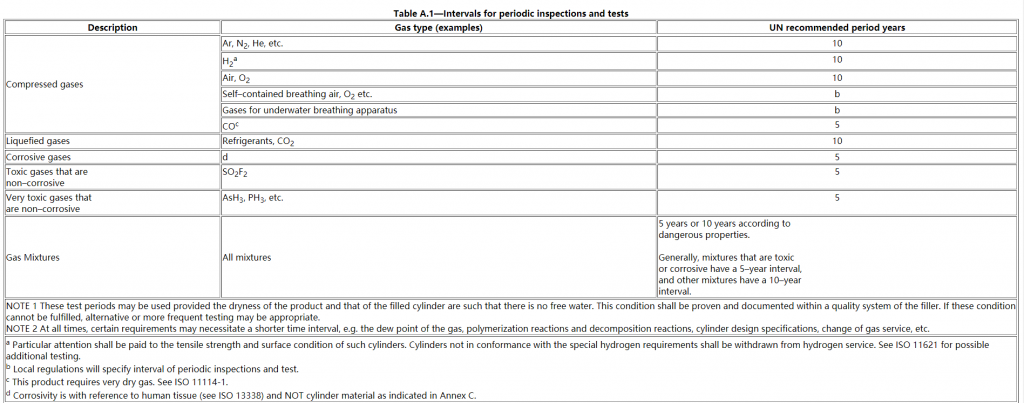
(normative)
Description, evaluation of defects and conditions for rejection of seamless steel gas cylinders at the time of visual inspection
B.1 General
Gas cylinder defects may be physical, material or due to corrosion as a result of environmental or service conditions to which the cylinder has been subjected during its life.
The object of this annex is to give general guidelines to gas cylinder inspectors as to the application of rejection criteria.
This annex applies to all cylinders, but those that have contained gases having special characteristics may require modified controls.
Any defect in the form of a sharp notch may be removed by grinding, machining or other approved methods.
After such a repair, the wall thickness shall be checked, e.g. ultrasonically.
B.2 Physical or material defects
Evaluation of physical or material defects shall be in accordance with Table B.1.
Permanent attachments (e.g. foot-rings or shrouds) shall be inspected and shall be suitable for their intended purposes.
B.3 Corrosion
B.3.1 General
The cylinder may be subjected to environmental conditions that could cause external corrosion of the metal.
Internal corrosion of the metal may also occur owing to service conditions.
There is difficulty in presenting definite rejection limits in tabular form for all sizes and types of cylinders and their service conditions. The limits of rejection are usually established following considerable field experience.
Extensive experience and judgment are required in evaluating whether cylinders that have corroded internally are safe and suitable for return to service. It is important that the surface of the metal is cleaned of corrosion products prior to the inspection of the cylinder.
B.3.2 Types of corrosion
The types of corrosion generally may be classified as in Table B.2.
22
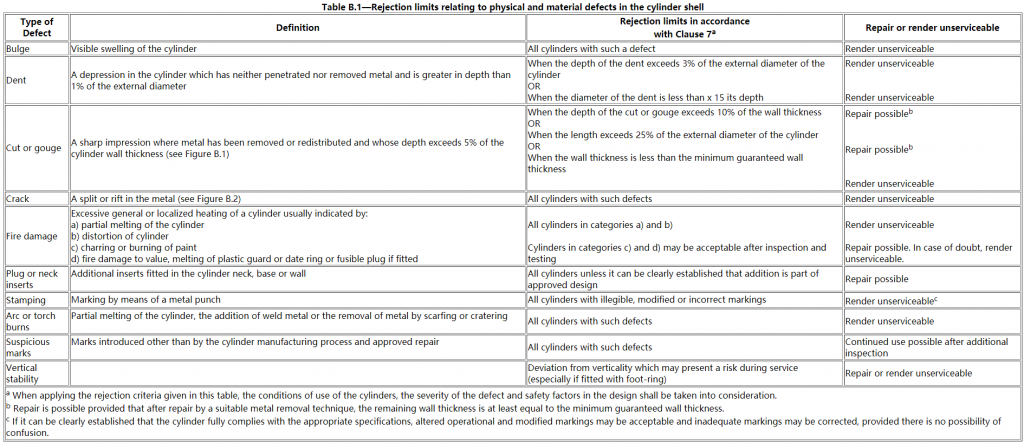
23
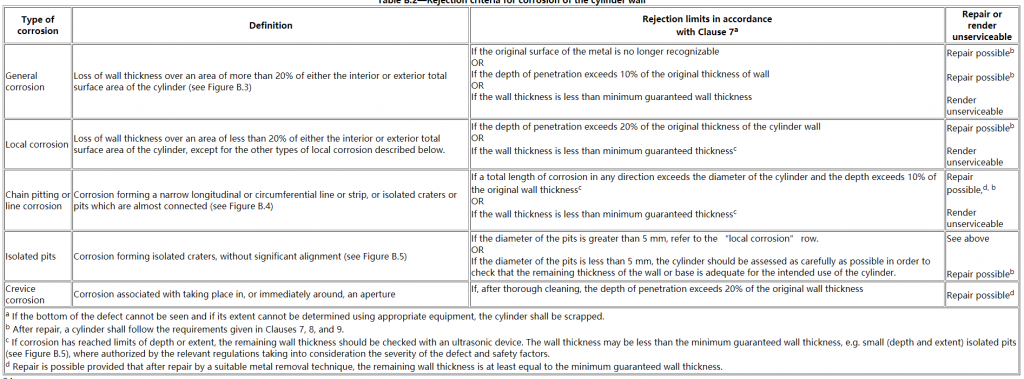
24

Figure B.1—Cut or gouge

Figure B.2—Crack

Figure B.3—General corrosion

Figure B.4—Channel (line) corrosion
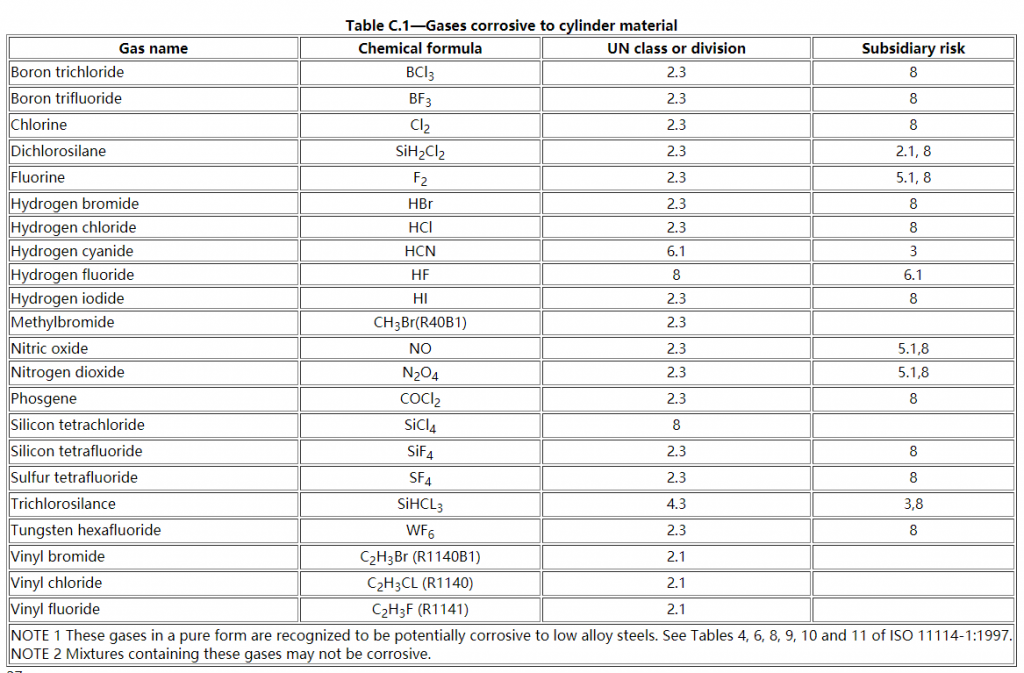
Figure B.5—Isolated pits26
Annex C
(informative)
List of gases corrosive to cylinder material
27
Annex D Gas cylinders Periodic inspection and testing
(normative)
Procedure to be adopted when de-valuing and/or when it is suspected that a cylinder valve is obstructed
D.1 Check for obstructed valve
The following procedures shall be carried out only by trained personnel. In view of the potential hazards in cylinders, this operation can lead to injury from stored energy release, fire and toxic hazards; hence, personnel shall take such precautions as deemed necessary for the work to be performed. When the gas, if any, has been released and the pressure within the cylinder reduced to atmospheric pressure, and, in the case of liquefied gases, when there is no frost or dew on the outside of the cylinder, the valve may be removed after an additional check is made to establish that there is free passage through the valve.
As indicated in Clause 6, a systematic check shall be made to establish that the passage through the valve is unobstructed. The method adopted shall be a recognized procedure such as one of the following or one that provides equivalent safeguards:
—by introducing a gas, non-reactive to the gas stored in the cylinder, at a pressure up to 5 bar and checking its discharge;
—by using the device shown in Figure D. 1 to hand-pump air into the cylinder
—for a cylinder of liquefied gas, first check to establish that the total weight of the cylinder is the same as the tare stamped on the cylinder. The cylinder may contain either liquefied gas under pressure or contaminants if there is a positive difference. Lack of a positive difference does not rule out the presence of a gas under pressure;
—for a valve incorporating a residual pressure device (e.g. see ISO 15996), the operator shall use a specific adapter to release the remaining pressure and verify the absence of pressure using one of the methods described previously.
D.2 Valve unobstructed
The cylinder valve may be removed only when it is established that there is no obstruction to gas flow. Personal protection during de-valuing shall be assessed.
D.3 Valve obstructed
The following methods apply to cylinders of non-toxic, non-flammable and non-chlorofluorocarbon (non-CFC) gases. Appropriate safety precautions should be taken to ensure that no hazard results from the uncontrolled discharge of any residual gas. When a cylinder is found to have an obstructed gas passage in the valve, the cylinder shall be set aside and handled by specially trained personnel in this task as follows:
—by sawing or drilling the valve body until interception is made with the gas passage between the valve body stem and the valve spindle seat. The operation shall be properly cooled particularly when handling oxidizing gases, or
—by loosening or piercing the pressure relief device in a controlled manner.28
The following methods apply to cylinders of toxic, flammable, air-reactive, water-reactive, oxidizing and CFC gases. After release, containment and subsequent disposal shall be carried out safely and without environmental impact.
—partially unscrew the valve within a glanded cap, secured and joined to the cylinder and vented to a safe discharge point. The principles of a suitable device are illustrated in Figure D.2. This procedure shall be performed in a controlled manner in such a way as to avoid personal injury or
—mechanically remove the valve in an enclosed, automatic device that will contain the release of gas and release of energy; or
—place the cylinder in a container suitable to contain the release of gas and release of energy, and crush or puncture the cylinder to release the material and pressure.

Figure D.1—Typical device for detecting obstructed cylinder valve29

Figure D.2—Typical device for the removal of a damaged gas cylinder valve30
Annex E Gas cylinders Periodic inspection and testing
(informative)
Volumetric expansion testing of gas cylinders
E.1 General
This annex gives details of the three methods for determining the volumetric expansion of steel gas cylinders:
—two water jacket methods (preferred method);
—the non-water jacket method.
The water jacket volumetric expansion test shall be carried out on equipment with a leveling burette, with a fixed burette or with a weighing scale that contains water.
E.2 Test equipment
The following general requirements shall apply to all three methods of test:
—hydraulic test pressure pipelines shall be capable of withstanding a pressure × 1,5 the maximum test pressure of any cylinder that may be tested;
—glass burette at the maximum recorded pressure shall be of sufficient length to contain the full volumetric expansion of the cylinder and shall have bores of uniform diameter such that the expansion can be read to an accuracy of 1 %, or 0,1 ml, whichever is greater;
—weighing scales shall be capable of providing total expansion measurements to an accuracy of ± 1% or 0,1 g, whichever is greater;
—pressure gauges shall be of the Industrial Class 1 with a scale appropriate to the test pressure; they shall be calibrated at regular intervals and at least once per month;
—a suitable system control device shall be used to ensure that no cylinder is subjected to a pressure in excess of its test pressure  or 10 bar, whichever is less;
or 10 bar, whichever is less;
—pipework should utilize long bends in preference to elbow fittings, and pressure pipes should be as short as possible; flexible tubing shall be capable of withstanding, 1,5 × the maximum test pressure in the equipment;
—all joints shall be leak tight;
—When installing equipment, care shall be taken to avoid trapping of air in the system.
E.3 Water jacket volumetric expansion test
E.3.1 General
This method of test necessitates enclosing the water-filled cylinder in a jacket that is also filled with water. The total and any permanent volumetric expansion of the cylinder are measured as to the amount of water displaced by the expansion of the cylinder when under pressure and after the pressure is released. The31
permanent expansion is calculated as a percentage of the total expansion. The water jacket shall be fitted with a safety device capable of releasing the energy from any cylinder that may burst at test pressure.
An air-bleed valve should be fitted to the highest point of the jacket.
Two methods for performing this test are described in E.3.2 and E.3.3. Other, equivalent methods are acceptable provided they are capable of measuring the total and, if any, permanent volumetric expansion of the cylinder.
E.3.2 Water jacket volumetric expansion test—Levelling burette method
The equipment should be installed as shown in Figure E. 1.

Figure E.1—Water jacket volumetric expansion test (levelling burette method)32
The procedure shall be as follows:
- fill cylinders with water and attach to water jacket cover;
- seal cylinder in jacket and fill jacket with water, allowing air to bleed off through air bleed valve;
- connect cylinder to pressure line. Adjust burette to zero level by manipulation of the jacket filling valve and drain valve. Raise pressure to two-thirds of test pressure, stop pumping and close hydraulic pressure supply valve. Check that burette reading remains constant;
- re-start pumping and open hydraulic pressure line valve until cylinder test pressure (
 or 10 bar, whichever is less) is reached. Close hydraulic pressure valve and stop pumping;
or 10 bar, whichever is less) is reached. Close hydraulic pressure valve and stop pumping; - lower burette until water level is at zero mark in burette support. Take a reading of the water level in burette at maximum recorded pressure. This reading is the total expansion and shall be recorded on the test certificate;
- open hydraulic line drain valve to release pressure from cylinder. Raise burette until water level is at zero on burette support. Check that pressure is at zero and that water level is constant;
- read water level in burette. This reading is the permanent expansion, if any, and shall be recorded on the test certificate;
- check that the permanent expansion (PE) does not exceed the percentage given in the design specification as determined by the following equation:

where TE is the total expansion.
E.3.3 Water jacket volumetric expansion test—Fixed burette method
The equipment should be installed as shown in Figure E.2.
The procedure for this method of test is similar to that described in E.3.2 except that the burette is fixed;
—adjust water level to a datum. Apply pressure until test pressure is reached and record the burette reading. The reading above the datum is the total expansion and shall be recorded on the test certificate;
—check that the permanent expansion does not exceed the percentage given in the design specification, as determined by the following equation:

33

Figure E.2—Water jacket volumetric expansion test (fixed burette method)
E.4 Non-water jacket volumetric expansion test
E.4.1 General
This method consists of measuring the amount of water passed into the cylinder under proof pressure, and on release of this pressure, measuring the water returned to the burette. It is necessary to allow for the compressibility of water and the volume of the cylinder under test to obtain true volumetric expansion. No fall in pressure under this test is permitted.
The water used should be clean and free of dissolved air. Any leakage from the system or the presence of free or dissolved air will result in false readings.
The equipment should be installed as shown in Figure E.3. This figure illustrates diagrammatically the different parts of the apparatus. The water supply pipe should be connected to an overhead tank as shown, or to some other supply giving a sufficient head of water.34

Figure E.3—Non-water jacket method—Diagrammatic layout of cylinder testing apparatus35
E.4.2 Requirement for testing
The apparatus shall be arranged such that all air can be removed and that accurate readings can be determined of the volume of water required to pressurize the filled cylinder and of the volume expelled from the cylinder when depressurized. In the case of larger cylinders, it may be necessary to augment the glass tube with metal tubes arranged in the manifold.
If a single-acting hydraulic pump is used, care shall be taken to ensure that the piston is in the “back” position when water levels are noted.
E.4.3 Test method
The test method shall be as follows:
- completely fill the cylinder with water and determine the weight of water required;
- connect the cylinder to the hydraulic test pump through the coil and check that all valves are closed;
- fill the pump and system with water from the tank by opening valves;
- to ensure the expulsion of air from the system, close the air-bleed and bypass valves and raise the system pressure to approximately one-third of the test pressure. Open the bleed valve to release the trapped air by reducing the system pressure to zero, and reclose the valve. Repeat if necessary;
- continue to fill the system until the level in the glass burette is approximately 300 mm from the top. Close the make-up valve and mark the water level with a pointer, leaving the isolating and air-bleed valves open. Record the level;
- close the air-bleed valve. Raise the pressure in the system until the pressure gauge records the required test pressure. Stop the pump and close the hydraulic line valve. After approximately 30s there should be no change in either the water level or the pressure. A change in level indicates leakage. A fall in pressure, if there is no leakage, indicates that the cylinder is still expanding under pressure;
- record the fall in water level in the glass tube (provided that there has been no leakage, all the water drained from the glass tube will have been pumped into the cylinder to achieve the test pressure). The difference in water level is the total volumetric expansion;
- open the hydraulic main and bypass valves slowly to release the pressure in the cylinder and allow the water so released to return to the glass tube. The water level should return to the original level marked by the pointer. Any difference in level will denote the amount of permanent volumetric expansion in the cylinder, neglecting the effect of the compressibility of the water at test pressure. The true permanent volumetric expansion of the cylinder shall be obtained by correcting for the compressibility of the water, which is given by the equation in E.4.4;
- before disconnecting the cylinder from the test rig, close the isolating valve. This will leave the pump and system full of water for the next test. Action d) shall, however, be repeated at each subsequent test;
- if permanent volumetric expansion has occurred, record the temperature of the water in the cylinder.
E.4.4 Calculation of compressibility of water
The formula used for the calculation of the compressibility of water shall be as follows:

36
where
C is the compressibility in square meters per newton (Pa-1);
m is the mass of water in kilograms;
P is the pressure in bar;
K is the factor for individual temperature as listed in Table E.1.

E.4.5 Calculation example
In the following example, allowance for pipe stretch has been neglected.
Test pressure = 232 bar
Mass of water in cylinder at zero gauge pressure = 113,8 kg
Temperature of water = 15 °C37
Water forced into cylinder to raise pressure to 232 bar = 1 745 cm3 (or 1, 745 kg)
Total mass of water, m, in cylinder at 232 bar = 113,8 + 1,745 = 115,545 kg
Water expelled from cylinder to depressurize = 1 742 cm3
Permanent expansion, PE = 1 745 − 1 742 = 3 cm3
From Table E.1, K factor for 15 °C = 0,047 25
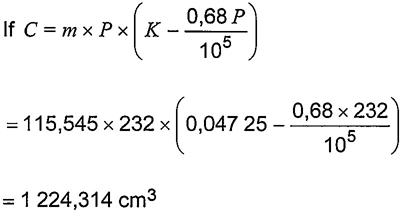
Total volumetric expansion, TE
TE = 1 745 − 1 224,314 = 520,686 cm3

38
Annex F
(informative)
Inspection and maintenance of valves and their junctions—Recommended procedures
All threads should be checked to ensure the thread diameters, form, length and taper are satisfactory.
If threads show signs of distortion, deformation or burring, these faults should be rectified. Excessive thread damage or serious deformation of the valve body, handwheel, spindle or other components is cause for replacement.
Maintenance of the valve should include general cleaning, together with replacement of elastomers and worn or damaged components, packing and safety devices, where necessary.
Where the use of lubricants/elastomers is permitted, only those approved for the gas service should be used, particularly for oxidizing gas service.
After the valve has been reassembled, it should be checked for correct operation and should undergo internal and external leak checks at intended operating pressure (for example, see ISO 10297 and ISO 14246). This may be done prior to the valve being refitted to the cylinder or during and after the first gas charge subsequent to the inspection and test of the cylinder.
For additional information, refer to EN 14189.39
Annex G
(informative)
Test date rings for gas cylinders
NOTE Systems other than the one specified in Table G.1 are in use, and the same system is used with different colours.

40
Bibliography (Gas cylinders Periodic inspection and testing)
- ISO 32, Gas cylinders—Colour coding
- ISO 7225, Gas cylinders—Precautionary labels
- ISO 9303, Seamless and welded (except submerged arc-welded) steel tubes for pressure purposes—Full peripheral ultrasonic testing for the detection of longitudinal imperfections
- ISO 9305, Seamless steel tubes for pressure purposes—Full peripheral ultrasonic testing for the detection of transverse imperfections
- ISO 9764, Electric resistance and induction welded steel tubes for pressure purposes—Ultrasonic testing of the weld seam for the detection of longitudinal imperfections
- ISO 10297, Gas cylinders—Refillable gas cylinder valves—Specification and type testing
- ISO 10298, Determination of toxicity of a gas or gas mixture
- ISO 10543, Seamless and hot-stretch-reduced welded steel tubes for pressure purposes—Full peripheral ultrasonic thickness testing
- ISO 11191, Gas cylinders—25E taper thread for connection of valves of gas cylinders—Inspection gauges
- ISO 12710, Non-destructive testing—Ultrasonic inspection—Evaluating electronic characteristics of ultrasonic test instruments
- ISO 13338, Determination of tissue corrosiveness of a gas or gas mixture
- ISO 14246, Transportable gas cylinders—Gas cylinder valves—Manufacturing tests and inspections
- ISO 15996, Gas cylinders—Residual pressure valves—General requirements and type testing
- EN 583-1, Non-destructive testing—Ultrasonic examination—Part 1: General principles
- EN 837-1, Pressure gauges—Part 1: Bourdon tube pressure gauges—Dimensions, metrology, requirements and testing
- EN 837-3, Pressure gauges—Part 3: Diaphragm and capsule pressure gauges—Dimensions, metrology, requirements and testing
- EN 14189, Transportable gas cylinders—Inspection and maintenance of cylinder valves at time of periodic inspection of gas cylinders
- Recommendations for the Transport of Dangerous Goods—Model Regulations, 13th edition, United Nations
41
ICS 23.020.30
Price based on 41 pages42




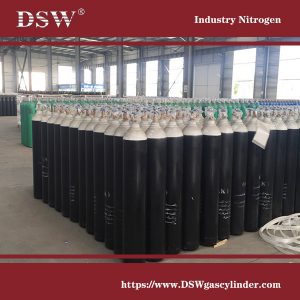

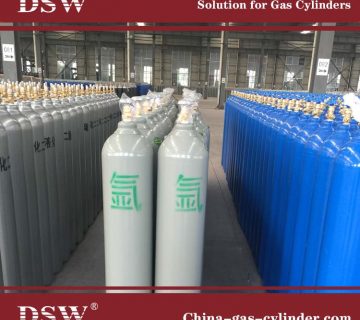
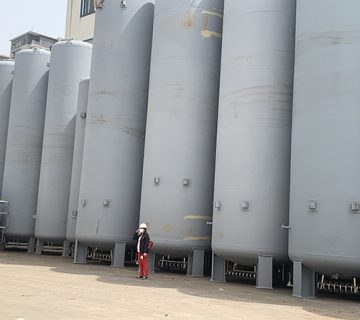
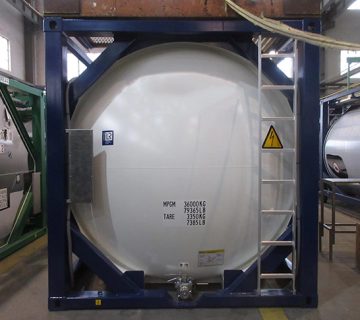
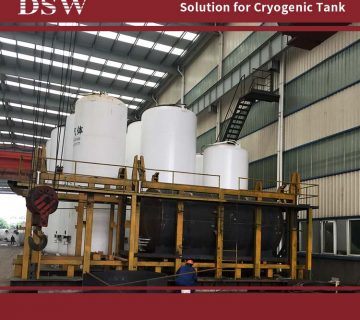
No comment